
chronos-forecasting
Chronos: Pretrained Models for Probabilistic Time Series Forecasting
Stars: 2831

Chronos is a family of pretrained time series forecasting models based on language model architectures. A time series is transformed into a sequence of tokens via scaling and quantization, and a language model is trained on these tokens using the cross-entropy loss. Once trained, probabilistic forecasts are obtained by sampling multiple future trajectories given the historical context. Chronos models have been trained on a large corpus of publicly available time series data, as well as synthetic data generated using Gaussian processes.
README:
- 26 Nov 2024: ⚡️ Chronos-Bolt models released on HuggingFace. Chronos-Bolt models are more accurate (5% lower error), up to 250x faster and 20x more memory efficient than the original Chronos models of the same size!
- 27 Jun 2024: 🚀 Released datasets used in the paper and an evaluation script to compute the WQL and MASE scores reported in the paper.
-
17 May 2024: 🐛 Fixed an off-by-one error in bin indices in the
output_transform. This simple fix significantly improves the overall performance of Chronos. We will update the results in the next revision on ArXiv. - 10 May 2024: 🚀 We added the code for pretraining and fine-tuning Chronos models. You can find it in this folder. We also added a script for generating synthetic time series data from Gaussian processes (KernelSynth; see Section 4.2 in the paper for details). Check out the usage examples.
- 19 Apr 2024: 🚀 Chronos is now supported on AutoGluon-TimeSeries, the powerful AutoML package for time series forecasting which enables model ensembles, cloud deployments, and much more. Get started with the tutorial.
- 08 Apr 2024: 🧪 Experimental MLX inference support added. If you have an Apple Silicon Mac, you can now obtain significantly faster forecasts from Chronos compared to CPU inference. This provides an alternative way to exploit the GPU on your Apple Silicon Macs together with the "mps" support in PyTorch.
-
25 Mar 2024: 🚀 v1.1.0 released with inference optimizations and
pipeline.embedto extract encoder embeddings from Chronos. - 13 Mar 2024: 🚀 Chronos paper and inference code released.
Chronos is a family of pretrained time series forecasting models based on language model architectures. A time series is transformed into a sequence of tokens via scaling and quantization, and a language model is trained on these tokens using the cross-entropy loss. Once trained, probabilistic forecasts are obtained by sampling multiple future trajectories given the historical context. Chronos models have been trained on a large corpus of publicly available time series data, as well as synthetic data generated using Gaussian processes.
For details on Chronos models, training data and procedures, and experimental results, please refer to the paper Chronos: Learning the Language of Time Series.

Fig. 1: High-level depiction of Chronos. (Left) The input time series is scaled and quantized to obtain a sequence of tokens. (Center) The tokens are fed into a language model which may either be an encoder-decoder or a decoder-only model. The model is trained using the cross-entropy loss. (Right) During inference, we autoregressively sample tokens from the model and map them back to numerical values. Multiple trajectories are sampled to obtain a predictive distribution.
The models in this repository are based on the T5 architecture. The only difference is in the vocabulary size: Chronos-T5 models use 4096 different tokens, compared to 32128 of the original T5 models, resulting in fewer parameters.
| Model | Parameters | Based on |
|---|---|---|
| chronos-t5-tiny | 8M | t5-efficient-tiny |
| chronos-t5-mini | 20M | t5-efficient-mini |
| chronos-t5-small | 46M | t5-efficient-small |
| chronos-t5-base | 200M | t5-efficient-base |
| chronos-t5-large | 710M | t5-efficient-large |
| chronos-bolt-tiny | 9M | t5-efficient-tiny |
| chronos-bolt-mini | 21M | t5-efficient-mini |
| chronos-bolt-small | 48M | t5-efficient-small |
| chronos-bolt-base | 205M | t5-efficient-base |
The following figure showcases the remarkable zero-shot performance of Chronos and Chronos-Bolt models on 27 datasets against local models, task-specific models and other pretrained models. For details on the evaluation setup and other results, please refer to the paper.

Fig. 2: Performance of different models on Benchmark II, comprising 27 datasets not seen by Chronos and Chronos-Bolt models during training. This benchmark provides insights into the zero-shot performance of Chronos and Chronos-Bolt models against local statistical models, which fit parameters individually for each time series, task-specific models trained on each task, and pretrained models trained on a large corpus of time series. Pretrained Models (Other) indicates that some (or all) of the datasets in Benchmark II may have been in the training corpus of these models. The probabilistic (WQL) and point (MASE) forecasting metrics were normalized using the scores of the Seasonal Naive baseline and aggregated through a geometric mean to obtain the Agg. Relative WQL and MASE, respectively.
To perform inference with Chronos or Chronos-Bolt models, the easiest way is to install this package through pip:
pip install chronos-forecastingIf you're interested in pretraining, fine-tuning, and other research & development, clone and install the package from source:
# Clone the repository
git clone https://github.com/amazon-science/chronos-forecasting.git
# Install in editable mode with extra training-related dependencies
cd chronos-forecasting && pip install --editable ".[training]"[!TIP]
This repository is intended for research purposes and provides a minimal interface to Chronos models. The recommended way of using Chronos for production use cases is through AutoGluon, which features effortless fine-tuning, augmenting Chronos models with exogenous information through covariate regressors, ensembling with other statistical and machine learning models, as well as seamless deployments on AWS with SageMaker 🧠. Check out the AutoGluon Chronos tutorial.
A minimal example showing how to perform forecasting using Chronos and Chronos-Bolt models:
import pandas as pd # requires: pip install pandas
import torch
from chronos import BaseChronosPipeline
pipeline = BaseChronosPipeline.from_pretrained(
"amazon/chronos-t5-small", # use "amazon/chronos-bolt-small" for the corresponding Chronos-Bolt model
device_map="cuda", # use "cpu" for CPU inference
torch_dtype=torch.bfloat16,
)
df = pd.read_csv(
"https://raw.githubusercontent.com/AileenNielsen/TimeSeriesAnalysisWithPython/master/data/AirPassengers.csv"
)
# context must be either a 1D tensor, a list of 1D tensors,
# or a left-padded 2D tensor with batch as the first dimension
# quantiles is an fp32 tensor with shape [batch_size, prediction_length, num_quantile_levels]
# mean is an fp32 tensor with shape [batch_size, prediction_length]
quantiles, mean = pipeline.predict_quantiles(
context=torch.tensor(df["#Passengers"]),
prediction_length=12,
quantile_levels=[0.1, 0.5, 0.9],
)For the original Chronos models, pipeline.predict can be used to draw forecast samples. More options for predict_kwargs in pipeline.predict_quantiles can be found with:
from chronos import ChronosPipeline, ChronosBoltPipeline
print(ChronosPipeline.predict.__doc__) # for Chronos models
print(ChronosBoltPipeline.predict.__doc__) # for Chronos-Bolt modelsWe can now visualize the forecast:
import matplotlib.pyplot as plt # requires: pip install matplotlib
forecast_index = range(len(df), len(df) + 12)
low, median, high = quantiles[0, :, 0], quantiles[0, :, 1], quantiles[0, :, 2]
plt.figure(figsize=(8, 4))
plt.plot(df["#Passengers"], color="royalblue", label="historical data")
plt.plot(forecast_index, median, color="tomato", label="median forecast")
plt.fill_between(forecast_index, low, high, color="tomato", alpha=0.3, label="80% prediction interval")
plt.legend()
plt.grid()
plt.show()A minimal example showing how to extract encoder embeddings from Chronos models:
import pandas as pd
import torch
from chronos import ChronosPipeline
pipeline = ChronosPipeline.from_pretrained(
"amazon/chronos-t5-small",
device_map="cuda",
torch_dtype=torch.bfloat16,
)
df = pd.read_csv("https://raw.githubusercontent.com/AileenNielsen/TimeSeriesAnalysisWithPython/master/data/AirPassengers.csv")
# context must be either a 1D tensor, a list of 1D tensors,
# or a left-padded 2D tensor with batch as the first dimension
context = torch.tensor(df["#Passengers"])
embeddings, tokenizer_state = pipeline.embed(context)Scripts for pretraining, fine-tuning and evaluating Chronos models can be found in this folder.
Datasets used in the Chronos paper for pretraining and evaluation (both in-domain and zero-shot) are available through the HuggingFace repos: autogluon/chronos_datasets and autogluon/chronos_datasets_extra. Check out these repos for instructions on how to download and use the datasets.
- Adapting language model architectures for time series forecasting (Amazon Science blog post)
- Amazon AI Researchers Introduce Chronos: A New Machine Learning Framework for Pretrained Probabilistic Time Series Models (Marktechpost blog post)
- Chronos: The Rise of Foundation Models for Time Series Forecasting (Towards Data Science blog post by Luís Roque and Rafael Guedes)
- Moirai: Time Series Foundation Models for Universal Forecasting (Towards Data Science blog post by Luís Roque and Rafael Guedes, includes comparison of Chronos with Moirai)
-
Chronos: The Latest Time Series Forecasting Foundation Model by Amazon (Towards Data Science blog post by Marco Peixeiro)
- The original article had a critical bug affecting the metric computation for Chronos. We opened a pull request to fix it.
- How to Effectively Forecast Time Series with Amazon's New Time Series Forecasting Model (Towards Data Science blog post by Eivind Kjosbakken)
- Chronos: Learning the Language of Time Series (Minimize Regret blog post by Tim Radtke)
- Chronos: Another Zero-Shot Time Series Forecaster LLM (Level Up Coding blog post by Level Up Coding AI TutorMaster)
- Paper Review: Chronos: Learning the Language of Time Series (Review by Andrey Lukyanenko)
- Foundation Models for Forecasting: the Future or Folly? (Blog post by Radix)
- Learning the Language of Time Series with Chronos (Medium post by Manuele Caddeo)
- The latest advancement in Time Series Forecasting from AWS: Chronos (Medium post by Abish Pius)
- Decoding the Future: How Chronos Redefines Time Series Forecasting with the Art of Language (Medium post by Zamal)
-
Comparison of Chronos against the SCUM ensemble of statistical models (Benchmark by Nixtla)
- We opened a pull request extending the analysis to 28 datasets (200K+ time series) and showing that zero-shot Chronos models perform comparably to this strong ensemble of 4 statistical models while being significantly faster on average. Our complete response can be found here.
- Comparison of Chronos against a variety of forecasting models (Benchmark by ReadyTensor)
If you find Chronos models useful for your research, please consider citing the associated paper:
@article{ansari2024chronos,
title={Chronos: Learning the Language of Time Series},
author={Ansari, Abdul Fatir and Stella, Lorenzo and Turkmen, Caner and Zhang, Xiyuan, and Mercado, Pedro and Shen, Huibin and Shchur, Oleksandr and Rangapuram, Syama Syndar and Pineda Arango, Sebastian and Kapoor, Shubham and Zschiegner, Jasper and Maddix, Danielle C. and Mahoney, Michael W. and Torkkola, Kari and Gordon Wilson, Andrew and Bohlke-Schneider, Michael and Wang, Yuyang},
journal={Transactions on Machine Learning Research},
issn={2835-8856},
year={2024},
url={https://openreview.net/forum?id=gerNCVqqtR}
}
See CONTRIBUTING for more information.
This project is licensed under the Apache-2.0 License.
For Tasks:
Click tags to check more tools for each tasksFor Jobs:
Alternative AI tools for chronos-forecasting
Similar Open Source Tools

chronos-forecasting
Chronos is a family of pretrained time series forecasting models based on language model architectures. A time series is transformed into a sequence of tokens via scaling and quantization, and a language model is trained on these tokens using the cross-entropy loss. Once trained, probabilistic forecasts are obtained by sampling multiple future trajectories given the historical context. Chronos models have been trained on a large corpus of publicly available time series data, as well as synthetic data generated using Gaussian processes.

Eco2AI
Eco2AI is a python library for CO2 emission tracking that monitors energy consumption of CPU & GPU devices and estimates equivalent carbon emissions based on regional emission coefficients. Users can easily integrate Eco2AI into their Python scripts by adding a few lines of code. The library records emissions data and device information in a local file, providing detailed session logs with project names, experiment descriptions, start times, durations, power consumption, CO2 emissions, CPU and GPU names, operating systems, and countries.
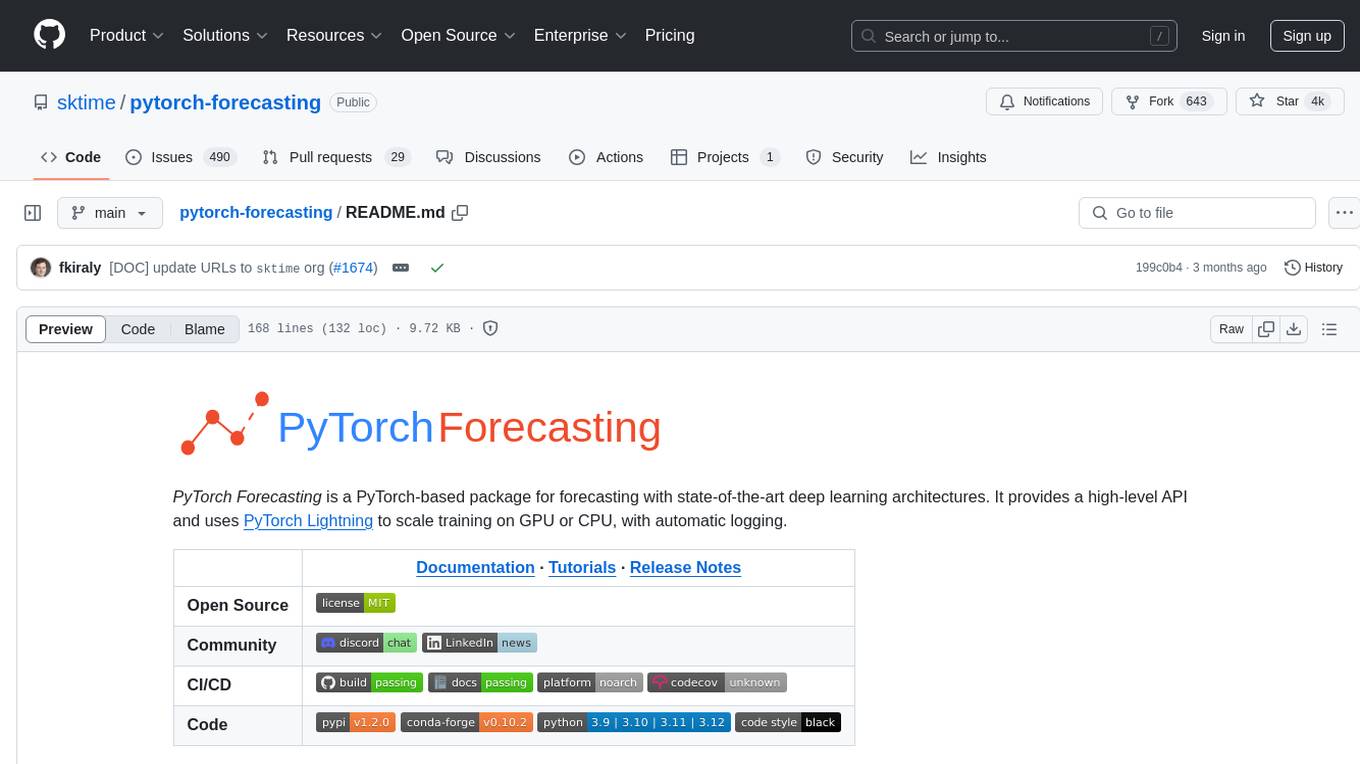
pytorch-forecasting
PyTorch Forecasting is a PyTorch-based package designed for state-of-the-art timeseries forecasting using deep learning architectures. It offers a high-level API and leverages PyTorch Lightning for efficient training on GPU or CPU with automatic logging. The package aims to simplify timeseries forecasting tasks by providing a flexible API for professionals and user-friendly defaults for beginners. It includes features such as a timeseries dataset class for handling data transformations, missing values, and subsampling, various neural network architectures optimized for real-world deployment, multi-horizon timeseries metrics, and hyperparameter tuning with optuna. Built on pytorch-lightning, it supports training on CPUs, single GPUs, and multiple GPUs out-of-the-box.

uqlm
UQLM is a Python library for Large Language Model (LLM) hallucination detection using state-of-the-art uncertainty quantification techniques. It provides response-level scorers for quantifying uncertainty of LLM outputs, categorized into four main types: Black-Box Scorers, White-Box Scorers, LLM-as-a-Judge Scorers, and Ensemble Scorers. Users can leverage different scorers to assess uncertainty in generated responses, with options for off-the-shelf usage or customization. The library offers illustrative code snippets and detailed information on available scorers for each type, along with example usage for conducting hallucination detection. Additionally, UQLM includes documentation, example notebooks, and associated research for further exploration and understanding.

catalyst
Catalyst is a C# Natural Language Processing library designed for speed, inspired by spaCy's design. It provides pre-trained models, support for training word and document embeddings, and flexible entity recognition models. The library is fast, modern, and pure-C#, supporting .NET standard 2.0. It is cross-platform, running on Windows, Linux, macOS, and ARM. Catalyst offers non-destructive tokenization, named entity recognition, part-of-speech tagging, language detection, and efficient binary serialization. It includes pre-built models for language packages and lemmatization. Users can store and load models using streams. Getting started with Catalyst involves installing its NuGet Package and setting the storage to use the online repository. The library supports lazy loading of models from disk or online. Users can take advantage of C# lazy evaluation and native multi-threading support to process documents in parallel. Training a new FastText word2vec embedding model is straightforward, and Catalyst also provides algorithms for fast embedding search and dimensionality reduction.
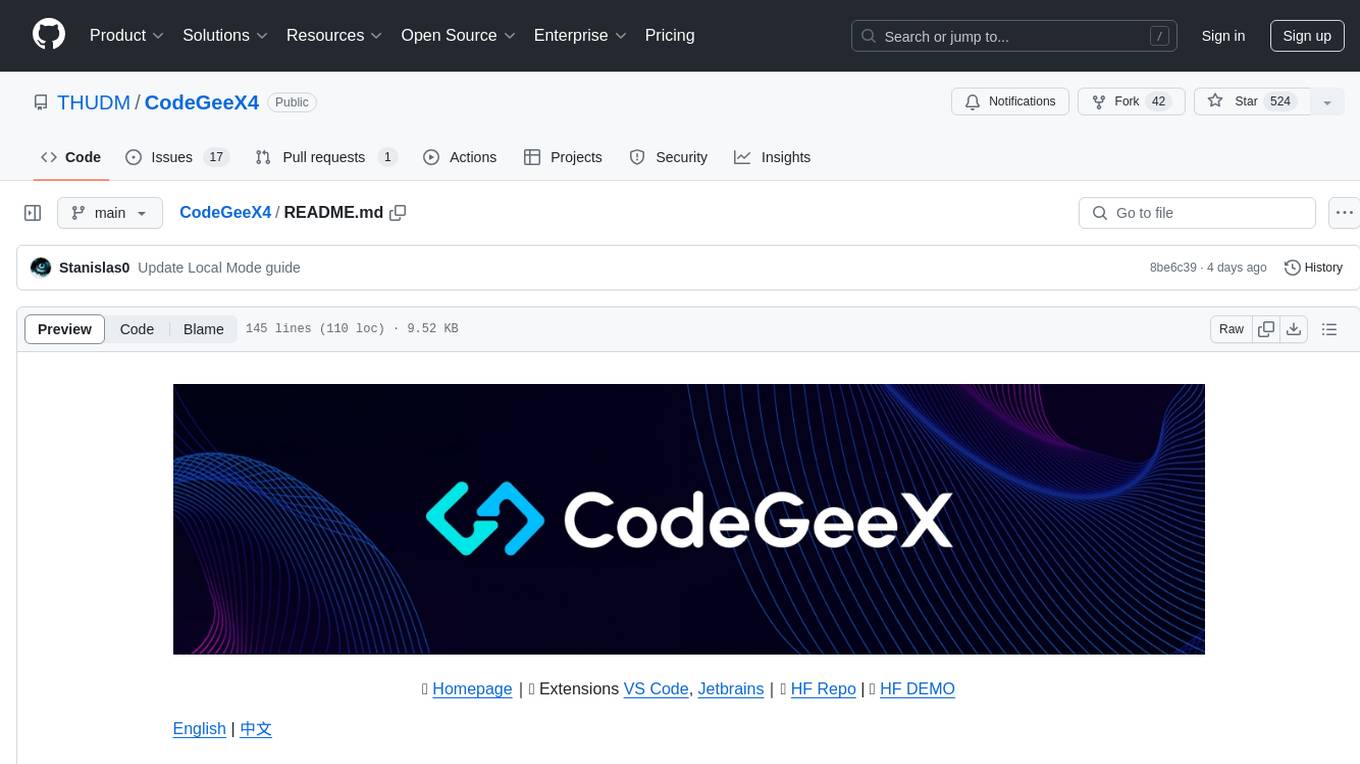
CodeGeeX4
CodeGeeX4-ALL-9B is an open-source multilingual code generation model based on GLM-4-9B, offering enhanced code generation capabilities. It supports functions like code completion, code interpreter, web search, function call, and repository-level code Q&A. The model has competitive performance on benchmarks like BigCodeBench and NaturalCodeBench, outperforming larger models in terms of speed and performance.

RD-Agent
RD-Agent is a tool designed to automate critical aspects of industrial R&D processes, focusing on data-driven scenarios to streamline model and data development. It aims to propose new ideas ('R') and implement them ('D') automatically, leading to solutions of significant industrial value. The tool supports scenarios like Automated Quantitative Trading, Data Mining Agent, Research Copilot, and more, with a framework to push the boundaries of research in data science. Users can create a Conda environment, install the RDAgent package from PyPI, configure GPT model, and run various applications for tasks like quantitative trading, model evolution, medical prediction, and more. The tool is intended to enhance R&D processes and boost productivity in industrial settings.
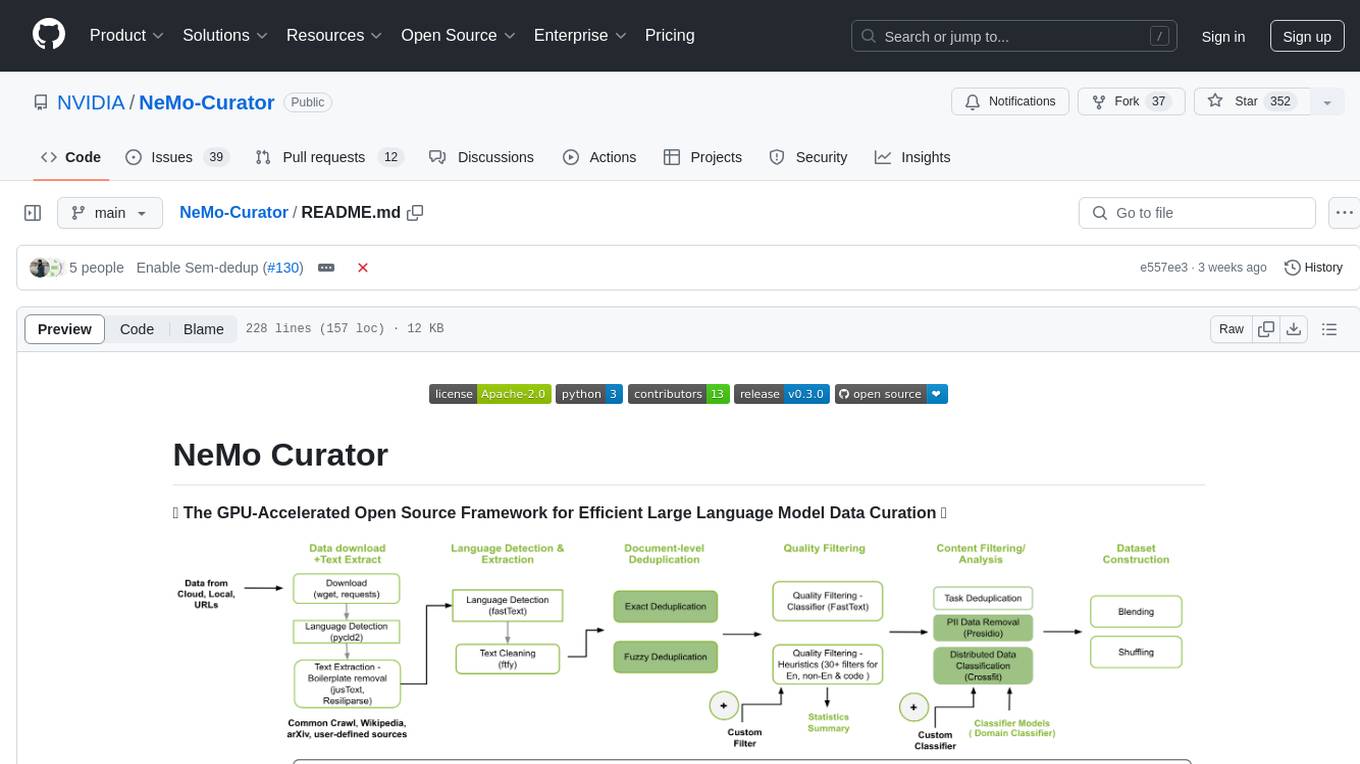
NeMo-Curator
NeMo Curator is a GPU-accelerated open-source framework designed for efficient large language model data curation. It provides scalable dataset preparation for tasks like foundation model pretraining, domain-adaptive pretraining, supervised fine-tuning, and parameter-efficient fine-tuning. The library leverages GPUs with Dask and RAPIDS to accelerate data curation, offering customizable and modular interfaces for pipeline expansion and model convergence. Key features include data download, text extraction, quality filtering, deduplication, downstream-task decontamination, distributed data classification, and PII redaction. NeMo Curator is suitable for curating high-quality datasets for large language model training.

llmware
LLMWare is a framework for quickly developing LLM-based applications including Retrieval Augmented Generation (RAG) and Multi-Step Orchestration of Agent Workflows. This project provides a comprehensive set of tools that anyone can use - from a beginner to the most sophisticated AI developer - to rapidly build industrial-grade, knowledge-based enterprise LLM applications. Our specific focus is on making it easy to integrate open source small specialized models and connecting enterprise knowledge safely and securely.

CuMo
CuMo is a project focused on scaling multimodal Large Language Models (LLMs) with Co-Upcycled Mixture-of-Experts. It introduces CuMo, which incorporates Co-upcycled Top-K sparsely-gated Mixture-of-experts blocks into the vision encoder and the MLP connector, enhancing the capabilities of multimodal LLMs. The project adopts a three-stage training approach with auxiliary losses to stabilize the training process and maintain a balanced loading of experts. CuMo achieves comparable performance to other state-of-the-art multimodal LLMs on various Visual Question Answering (VQA) and visual-instruction-following benchmarks.

FATE-LLM
FATE-LLM is a framework supporting federated learning for large and small language models. It promotes training efficiency of federated LLMs using Parameter-Efficient methods, protects the IP of LLMs using FedIPR, and ensures data privacy during training and inference through privacy-preserving mechanisms.
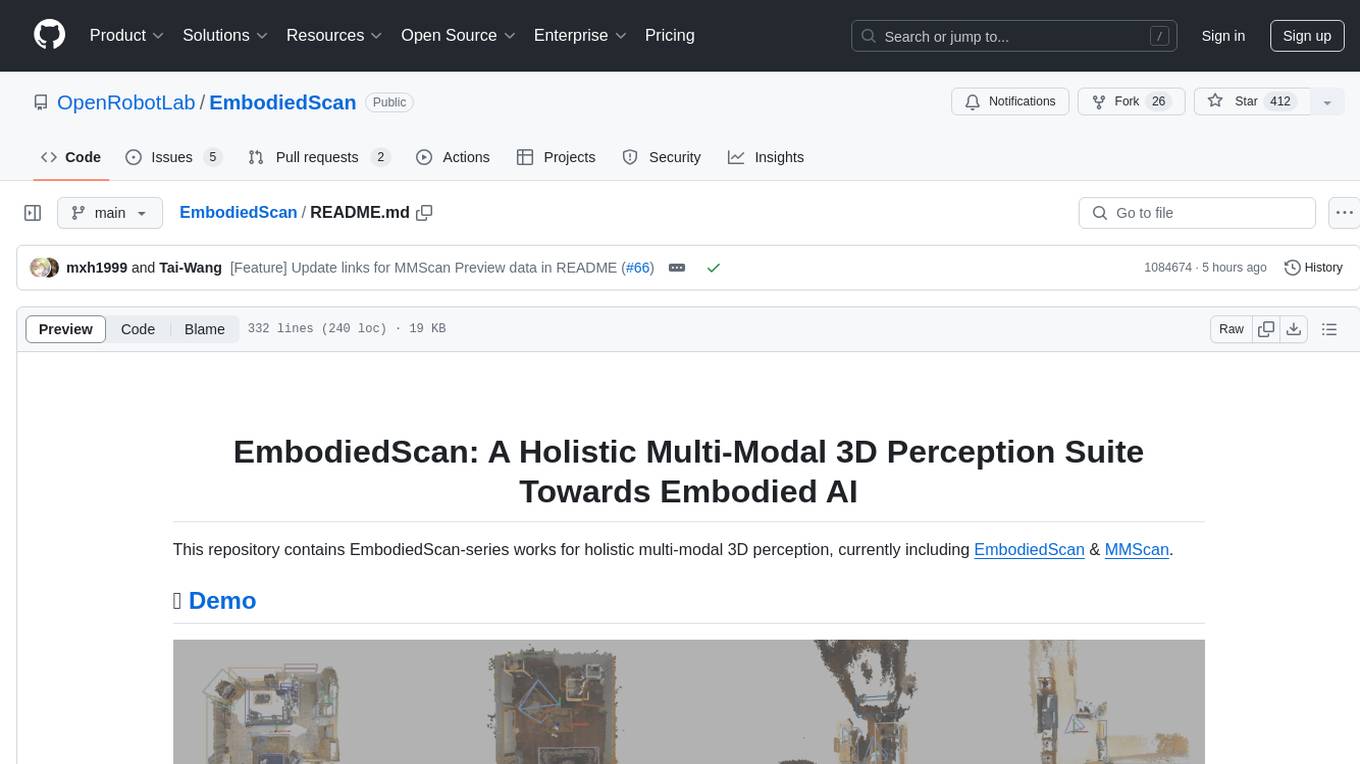
EmbodiedScan
EmbodiedScan is a holistic multi-modal 3D perception suite designed for embodied AI. It introduces a multi-modal, ego-centric 3D perception dataset and benchmark for holistic 3D scene understanding. The dataset includes over 5k scans with 1M ego-centric RGB-D views, 1M language prompts, 160k 3D-oriented boxes spanning 760 categories, and dense semantic occupancy with 80 common categories. The suite includes a baseline framework named Embodied Perceptron, capable of processing multi-modal inputs for 3D perception tasks and language-grounded tasks.

AceCoder
AceCoder is a tool that introduces a fully automated pipeline for synthesizing large-scale reliable tests used for reward model training and reinforcement learning in the coding scenario. It curates datasets, trains reward models, and performs RL training to improve coding abilities of language models. The tool aims to unlock the potential of RL training for code generation models and push the boundaries of LLM's coding abilities.

FuseAI
FuseAI is a repository that focuses on knowledge fusion of large language models. It includes FuseChat, a state-of-the-art 7B LLM on MT-Bench, and FuseLLM, which surpasses Llama-2-7B by fusing three open-source foundation LLMs. The repository provides tech reports, releases, and datasets for FuseChat and FuseLLM, showcasing their performance and advancements in the field of chat models and large language models.
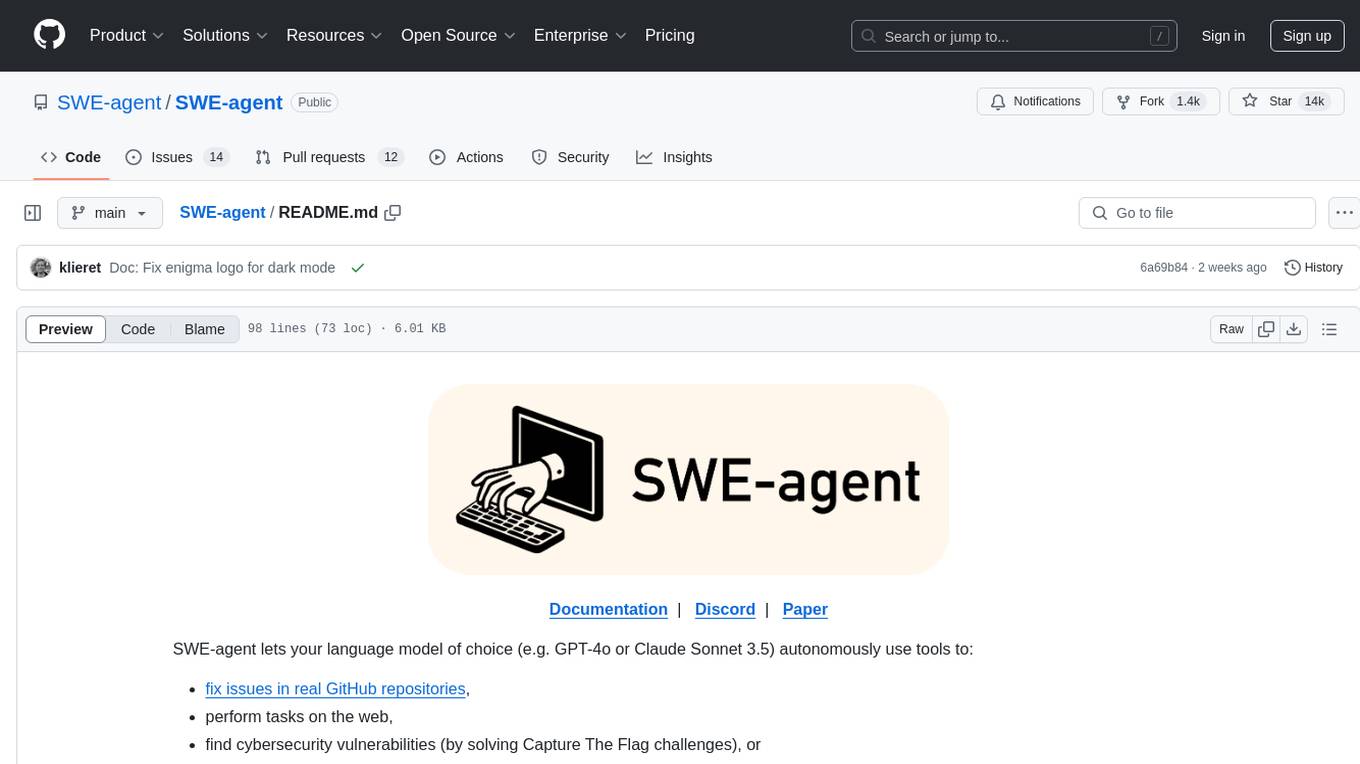
SWE-agent
SWE-agent is a tool that allows language models to autonomously fix issues in GitHub repositories, perform tasks on the web, find cybersecurity vulnerabilities, and handle custom tasks. It uses configurable agent-computer interfaces (ACIs) to interact with isolated computer environments. The tool is built and maintained by researchers from Princeton University and Stanford University.

SEED-Bench
SEED-Bench is a comprehensive benchmark for evaluating the performance of multimodal large language models (LLMs) on a wide range of tasks that require both text and image understanding. It consists of two versions: SEED-Bench-1 and SEED-Bench-2. SEED-Bench-1 focuses on evaluating the spatial and temporal understanding of LLMs, while SEED-Bench-2 extends the evaluation to include text and image generation tasks. Both versions of SEED-Bench provide a diverse set of tasks that cover different aspects of multimodal understanding, making it a valuable tool for researchers and practitioners working on LLMs.
For similar tasks

chronos-forecasting
Chronos is a family of pretrained time series forecasting models based on language model architectures. A time series is transformed into a sequence of tokens via scaling and quantization, and a language model is trained on these tokens using the cross-entropy loss. Once trained, probabilistic forecasts are obtained by sampling multiple future trajectories given the historical context. Chronos models have been trained on a large corpus of publicly available time series data, as well as synthetic data generated using Gaussian processes.

mlcourse.ai
mlcourse.ai is an open Machine Learning course by OpenDataScience (ods.ai), led by Yury Kashnitsky (yorko). The course offers a perfect balance between theory and practice, with math formulae in lectures and practical assignments including Kaggle Inclass competitions. It is currently in a self-paced mode, guiding users through 10 weeks of content covering topics from Pandas to Gradient Boosting. The course provides articles, lectures, and assignments to enhance understanding and application of machine learning concepts.
For similar jobs

chronos-forecasting
Chronos is a family of pretrained time series forecasting models based on language model architectures. A time series is transformed into a sequence of tokens via scaling and quantization, and a language model is trained on these tokens using the cross-entropy loss. Once trained, probabilistic forecasts are obtained by sampling multiple future trajectories given the historical context. Chronos models have been trained on a large corpus of publicly available time series data, as well as synthetic data generated using Gaussian processes.





